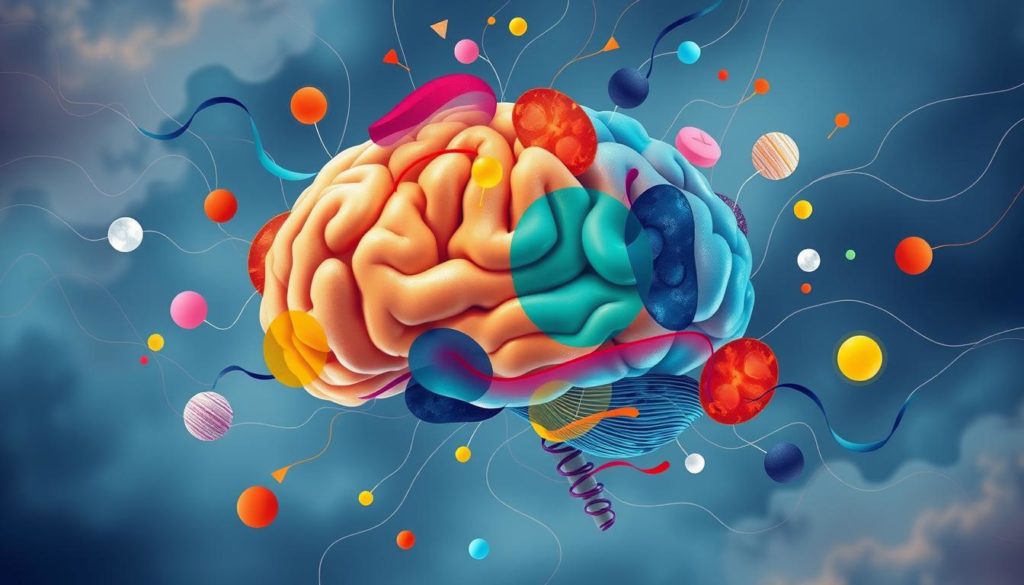Escitalopram is a type of medicine called a selective serotonin reuptake inhibitor (SSRI). It’s often used to help people with depression and anxiety. This drug increases serotonin levels in the brain to improve mood and lessen anxiety symptoms. Most people begin to see its full effects in 4 to 6 weeks.
It’s important to consider both the good and the bad side of taking Escitalopram. Knowing about possible side effects and drug interactions is key for its safe use.
Escitalopram comes in both pill and liquid forms by prescription. Knowing about its benefits and risks is essential for anyone thinking of starting this medication.
What is Escitalopram?
Escitalopram is a popular antidepressant that helps with mood disorders. It’s a Selective Serotonin Reuptake Inhibitor (SSRI). SSRIs boost serotonin in the brain, which is key for mood balance. This makes escitalopram a top choice for treating depression.
Description
As an SSRI, escitalopram focuses on fixing serotonin imbalances in the brain. It stops serotonin from being taken back up. This action raises serotonin levels, helping to elevate mood and ease anxiety. It is often prescribed for depression and generalized anxiety disorder (GAD).

Brand Names
In the US, Lexapro is the well-known brand name for escitalopram. It comes in tablets and liquid forms to meet various needs. In Canada, it’s called ACT-Escitalopram ODT.
| Country | Brand Name | Form |
|---|---|---|
| United States | Lexapro | Tablet, Solution |
| Canada | ACT-Escitalopram ODT | Tablet, Solution |
How Escitalopram Works in the Brain
Escitalopram affects the brain in a way that helps people feel better. This antidepressant is part of the SSRIs group. It changes brain chemistry. This helps reduce depression and anxiety troubles.

Mechanism of Action
Escitalopram works by stopping the reuptake of serotonin in the brain. Serotonin is a key mood regulator. By preventing its reuptake, more serotonin stays in the spaces between brain cells.
This increase in serotonin improves mood and lowers anxiety with regular use. It makes a big difference over time.
Effects on Serotonin Levels
Raising serotonin levels is key to how Escitalopram works. More serotonin in the brain can greatly improve mental health. It helps lessen feelings of depression and anxiety.
Usually, people start feeling better 4 to 6 weeks after taking the medication. This gives a good insight into the side effects of Escitalopram and how it benefits mental wellness.
Common Uses of Escitalopram
Escitalopram is known as Lexapro. It’s a key player in treating various mental health issues. It’s mainly used for major depressive disorder and generalized anxiety disorder.
But its benefits extend further. It’s also effective for OCD treatment and managing panic attacks.
If you’re dealing with anxiety management, Lexapro could really help. It improves how your brain handles serotonin. This is a big deal because it has fewer side effects than older antidepressants.
This means people are more likely to stick with their treatment. And that leads to better results in tackling mental health issues.
Here’s a quick look at what Escitalopram can do:
| Condition | Effectiveness | Comments |
|---|---|---|
| Major Depressive Disorder | High | Noted for significant improvement in mood and overall well-being. |
| Generalized Anxiety Disorder | High | Reduces anxiety, resulting in better daily function. |
| OCD Treatment | Moderate to High | Helps in reducing obsessive thoughts and compulsions. |
| Panic Attacks | Moderate | Effective in preventing the onset of panic episodes. |
In summary, Escitalopram, or Lexapro, is very important for mental health. It helps a lot of people with depression, anxiety, OCD, and panic attacks.
Different Forms of Escitalopram
Escitalopram comes in different medication forms to meet various needs. There are two main SSRI administration options: tablets and oral solution. Each type has special benefits.
Tablet
Tablets of Escitalopram are popular and easy to use. They come with marks like “P 20”, “IG 249”, and “F 5 6”. These marks show different strengths. They help doctors and patients keep track of dosages. Tablets are made in 5 mg, 10 mg, and 20 mg strengths. This means each patient gets a treatment plan that fits them.
Solution
The escitalopram oral solution is great for those who find pills hard to swallow. It’s a liquid, so getting the right dose is easy. It lets doctors adjust the dose more precisely.
That way, treatment can be very specific to each person’s need. For instance, the liquid can be measured out in smaller amounts than pills. So, treatment becomes more adaptable.
| Medication Form | Common Dosages | Benefits |
|---|---|---|
| Tablet | 5 mg, 10 mg, 20 mg | Convenient, easy administration, recognizable dosage |
| Oral Solution | Custom increments | Flexible dosage, ideal for those with swallowing difficulties |
Knowing the different medication forms of Escitalopram helps make treatment plans better. It makes sure patients get their SSRI administration in the way that works best for them.
Benefits of Using Escitalopram for Mental Health
Escitalopram is a top-notch SSRI critical for mental wellness. It’s highly effective in treating depression and anxiety.
Treatment of Depression
Its main advantage is its power in fighting depression. By boosting serotonin, it brightens mood and betters mental health. People with depression notice significant symptom drops and can enjoy life again.
Anxiety Management
Escitalopram also battles generalized anxiety disorder (GAD) well. It lifts serotonin, easing anxiety woes for many. This SSRI shines in tackling both long-standing and sudden anxiety, showing its wide-ranging healing impact.
Other Disorders
But there’s more—escitalopram is sometimes used for other issues. It can level out mood, aiding in OCD and panic attacks. Its vast benefits highlight its role in boosting mental health widely.
| Condition | Primary Benefit |
|---|---|
| Depression | Aids in depression recovery |
| Generalized Anxiety Disorder | Manages anxiety symptoms effectively |
| Obsessive-Compulsive Disorder | Stabilizes mood |
Potential Side Effects of Escitalopram
Escitalopram helps a lot with mental health issues. But, it’s important to know about possible side effects. Knowing the common and serious side effects helps patients and doctors make better choices.
Common Side Effects
Some common side effects are:
- Nausea
- Dry mouth
- Dizziness
- Headaches
- Increased sweating
These side effects usually get better after a few weeks. It’s key to be patient as your body gets used to the medicine. Always tell your doctor if the side effects don’t go away.
Serious Side Effects
Some serious side effects need immediate doctor’s attention:
- Increased risk of suicidal thoughts, especially in young adults
- Big mood or behavior changes
- Severe muscle stiffness or shaking
- Easy bleeding or bruising
- Allergic reactions like rash, itching, or swelling
It’s very important to notice these serious symptoms. Telling your doctor right away can really help your treatment and keep you safe.
Escitalopram Dosage Guidelines
Finding the right Escitalopram Dosage needs careful thought and regular tweaks. This customizes the treatment for each person.
Initial Dosages
Starting with a small dose of Escitalopram is usual. It checks how the patient reacts. It also limits side effects while helping the patient. Initially, adults often start at 10 mg a day, following Prescription Guidelines. A smaller dose might be needed for teens and the elderly, based on their health.
Adjustments Over Time
Adjusting the medicine is crucial for its success. After the start, the dose may be increased slowly, depending on how well it works and is tolerated. These increases, suggested by doctors, help find the best dose. If 10 mg isn’t enough, it might be raised to 20 mg a day, with a doctor’s guidance. This makes sure the treatment works well but stays safe.
- Initial dosage: 10 mg per day
- Standard dosage for adolescents/elderly: Lower initial dose
- Typical dosage range: 10-20 mg per day
Following Prescription Guidelines and talking to a healthcare provider about any needed Medication Adjustments is crucial. Everyone reacts differently to medications, so treatments must be tailored.
Important Drug Interactions
Knowing how Escitalopram interacts with other drugs is key. This drug is also known as Lexapro. Being aware helps prevent side effects or less effective results. It’s important to know which medicines to avoid and understand possible drug interactions.
Medications to Avoid
Some drugs should not be mixed with Escitalopram to avoid harmful effects. MAO inhibitors like isocarboxazid and phenelzine are very risky with Lexapro. Certain antipsychotics, such as pimozide, are also dangerous. Mixing these can cause serious side effects. This shows why it’s so important to manage your medications wisely and talk with your doctor.
Potential Interactions
There are other medicines that might affect how Escitalopram works, even if they’re not as dangerous. It’s good to know about these to avoid any issues. Here’s a table listing some common drug interactions:
| Medication Class | Examples | Potential Interaction |
|---|---|---|
| Anticoagulants | Warfarin | Increased bleeding risk |
| NSAIDs | Ibuprofen, Naproxen | Increased bleeding risk |
| Other SSRIs/SNRIs | Fluoxetine, Sertraline | Increased serotonin syndrome risk |
| Triptans | Sumatriptan, Rizatriptan | Increased serotonin syndrome risk |
| Tramadol | Tramadol | Increased serotonin syndrome risk |
Always talk to a healthcare provider before starting new medicines, OTC drugs, and supplements. This is key for using Escitalopram safely. Proper management ensures you stay safe while getting the benefits of Lexapro.
Considerations Before Using Escitalopram
Before starting escitalopram, know how it affects different groups. It’s usually effective but requires caution with children, the elderly, and those pregnant or breastfeeding.
Pediatric Use
Escitalopram is approved for kids 12 and up. Its impact on children under 12 is unknown. Doctors should consider the pros and cons, noting kids may react differently than adults.
Use in Elderly Patients
When prescribing escitalopram to elderly patients, care is key. They may have more side effects, like hyponatremia. It’s crucial to adjust doses and monitor these patients closely.
Use During Pregnancy and Breastfeeding
Pregnant women should talk to their doctor about escitalopram. The effects on unborn babies are complicated. Breastfeeding moms must also be cautious, as escitalopram enters breast milk. They should discuss the benefits and risks with their doctor.
Managing Withdrawals and Discontinuation
Stopping Escitalopram safely is more than just quitting the medication. It’s vital to know the right steps and strategies. This helps manage withdrawal from Escitalopram well and prevents serious symptoms.
Gradual Reduction Strategy
The best way to stop taking Escitalopram is by slowly lowering the dose. This method, called medication tapering, involves cutting down the dose gradually. It helps avoid severe withdrawal symptoms like trouble focusing, dizziness, and mood changes.
A healthcare provider will guide the tapering process. They ensure the dose reduction matches the patient’s health and reaction.
Potential Withdrawal Symptoms
Withdrawal symptoms are common when stopping Escitalopram. Symptoms can include nausea, headaches, tiredness, and irritability. The severity and length of these symptoms can differ from person to person.
Some may have mild symptoms, while for others, it might be tougher. Regular check-ins with a healthcare provider can ease these symptoms. This makes stepping down from Escitalopram easier and more bearable.
Practical Tips for Taking Escitalopram Safely
Taking Escitalopram safely requires you to follow some key steps. Get tips from doctors to improve your treatment and lower risks. Here, we have listed some helpful advice for you.
Best Practices
Always take the exact dose your doctor gives you. Do not stop or change your dose on your own. This can cause bad effects or withdrawal. It’s important to talk to your doctor about any side effects or mood changes. They can adjust your treatment if needed. Also, be aware of how Escitalopram might react with other drugs, like MAO inhibitors or pimozide.
For detailed info, please visit this resource.
Precautions to Take
Before starting Escitalopram, tell your doctor about any other meds or supplements you’re taking. This helps avoid harmful interactions and ensures a safer treatment. Avoid alcohol and be careful when driving or using machines until you know how the drug affects you.
Watch out for signs of serotonin syndrome, changes in behavior, and other serious side effects. Tell your doctor right away if you notice anything unusual. For a complete guide on Escitalopram safety, always use trusted sources and keep talking to your healthcare team. Following these tips can help you manage your mental health care better and reach your treatment goals.
FAQ
What is Escitalopram?
Escitalopram is an antidepressant in the SSRI class. It treats major depressive disorder and anxiety. It boosts serotonin in the brain to improve mood.
What are the common brand names for Escitalopram?
In the US, it’s known as Lexapro. In Canada, it’s called ACT-Escitalopram ODT.
How does Escitalopram work in the brain?
It stops serotonin from being taken back into neurons. This increases serotonin in the brain. Higher serotonin levels help with depression and anxiety.
What are the common uses of Escitalopram?
It’s used for depression and anxiety. It also helps with OCD and panic attacks.
In what forms is Escitalopram available?
You can get it as a pill or liquid. The pill has different dosages. The liquid is for those who can’t swallow pills.
What are the benefits of using Escitalopram for mental health?
It helps a lot with depression and anxiety. It also works for OCD and panic attacks. It improves mood and life quality.
What are the common side effects of Escitalopram?
Side effects include nausea, headaches, and insomnia. They usually go away. Some might get serious side effects like suicidal thoughts.
How is Escitalopram dosage typically determined?
The dose is based on the patient’s needs. It starts low and can go up. The aim is to balance benefits and side effects.
What are some important drug interactions to be aware of with Escitalopram?
Avoid MAO inhibitors and some antipsychotics. Always tell your doctor about all medicines you take.
Are there any special considerations before using Escitalopram?
Use it carefully in different age groups and conditions. It’s okay for kids 12 and up but not younger. Pregnant and nursing moms should talk to their doctors. Watch elderly patients for certain side effects.
How should one manage withdrawals and discontinuation of Escitalopram?
Stop Escitalopram slowly with doctor’s advice. This avoids withdrawal symptoms. A tapering method is best.
What are some practical tips for taking Escitalopram safely?
Follow your prescription closely. Talk to your healthcare provider about side effects. Know drug interactions and don’t drive if it affects you.


